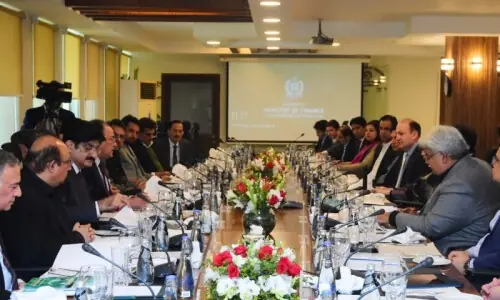If social and bulk of conventional media is to be believed, Kalabagh Dam alone is the solution to all our energy woes. Posts circulating on social media ‘declare’ a cost of Rs 0.5 to Rs 1.5 per unit of electricity to be generated from KBD.
Interestingly, considering that the rupee has depreciated against USD over the last two decades and construction costs have gone up, one would have expected the cost to build the dam/plant and the ensuing cost to generate power to increase accordingly. But this is in stark contrast to the verdict on KBD tariff on social media where it, somehow, decreases every other month.
Without commenting on the commercial (and political) viability of KBD, exactly how cheap can hydel tariffs be?
What about the cost to recover the massive investment that such large-scale projects entail?
And do they run throughout the year?
Some fun facts: Did you know that the Tarbela Hydel Power Station, Pakistan’s largest dam and hydel plant with a total power generation rating of 3478MW, produced on average only 1733MW (less than 50pc) during the whole FY2013-14?
Did you know that 50pc ‘capacity factor’ is generally the average for ALL our hydel plants?
Scam? No.
In my earlier piece, I had argued that all renewable-based power plants — solar, wind and hydel — have low capacity factors when compared to conventional fuel-based plants. This is because the availability of natural resources is neither uniform nor guaranteed. This intermittence makes ‘green’ energy less reliable as compared to thermal power.
To know our ‘best bet’ for power generation we can try and compare the various energy source types on four key dimensions:
Capital cost (the cost to build)
Time to build (opportunity cost of ‘no power’)
Capacity factor (dependency or reliability)
Levellised tariff (the cost to consumer)
Admittedly, there are other factors, both positive and negative, that accompany these projects such as environmental impact (‘dirty’ coal vs ‘green’ solar), displacement issues of local communities, safety concerns (nuclear plants) etc. that can have serious long-term economic implications.
However, in the absence of any reliable method to quantify, these largely remain limited to opinions.
Hydel
Hydel power plants can be divided into two types based on their nature: run-of-the-river type and reservoir type. The latter, as the name suggests, involves building a water storage dam, which helps in regulating the flow of water.
Besides power generation, these dams are also frequently used for irrigation and flood-control purposes. These are mega structures and require large amounts of money and time to build compared to run-of-the-river hydel projects.
The 969MW Neelum Jhelum project, which is currently under-construction, is an example of a run-of-the-river hydel plant. Having gone through significant delays and substantial cost revisions (typical for almost all public-funded large-scale projects), it is expected to get operational in early 2017. By that time, the project would have consumed $4.1bn in cost ($4.23mn/MW) and about eight years in construction. The plant will have an annual capacity factor of 61pc and a tariff of around 11 cents/unit (estimated).
Solar
Zoenergy, a Chinese company, is setting up a 900MWp solar plant at Quaid-i-Azam Solar Park (QASP). By the time it completes (expected end of 2016), the QASP, with a combined capacity of 1000MWp, will become the largest solar power plant in the world.
The total project cost is expected to be $1.5bn ($1.73mn/MW) and comes with a tariff of 14.15 cents.
At a capacity factor of 17.5pc, the total plant setup time will be staggered over 18 months, making it the quickest among all power projects.
Wind
AEDB estimates a wind energy potential of 60,000MW electricity from the Gharo-Keti Bandar wind corridor. A number of 50MW wind farms are under-construction and are expected to commence commercial operations in 2016 and 2017.
An advantage of wind power over solar is the former’s high capacity factor of 35pc (almost twice that of solar). In terms of similarities, just like solar, wind power projects come with large price tags.
The under-construction 99MW United Energy wind farm at Jhimpir has a total project cost of $261.5mn ($2.64mn/MW) and a construction period of 18 months (due June 2016). Operating at a capacity factor of 35pc, it will sell electricity to the grid at a levellised tariff of 13.52 cents/unit.
Nuclear
Nuclear energy remains one of the cheapest (and most controversial) sources of energy. Incidents like Fokoshima and Chernobyl are destined to remain grim reminders of the inherent danger nuclear energy can possess. Two 1100MW (2 x 1100) nuclear power plants, KANUPP-2 and KANNUP-3, based on Chinese technology, are being set up in Karachi.
The KANUPP-2 project, due for completion in early 2019, is estimated to have a capital cost of staggering $4.7bn ($4.3mn/MW). At a capacity factor of 90pc, the project's levellised cost of energy will be in around 9.59 cents per unit.
Leaving aside the safety and geo-political issues inherent with nuclear plants, the cost (both in terms of capital cost and tariff) remains on the higher side. The biggest benefit of such plants comes in the form of high availability/capacity factor (around 90pc) which makes them quite reliable in terms of regular supply.
Coal
Coal remains the largest and the cheapest source of energy in the world today. US generated 39pc of its electricity through coal in 2014. Its contribution to the country’s total power generation is 74pc in China (2014) and 66pc in India (2014). And while environmental considerations are forcing the developed world to move away from coal, it is expected to remain a dominant energy source for the foreseeable future.
The contribution of coal in Pakistan’s energy mix is close to zero.
This situation, for a country, that has one of the largest, albeit low quality, reserves of coal remains counter-intuitive. There is little to suggest that this aversion to coal was driven by carbon emissions, rather had more to do with government policies which chose to rely on furnace oil and gas-based power generation.
Presently, a number of coal-based power plants, based on local and imported coal, are under various stages of development in the country.
A 1,320MW plant is being built (due for COD in December 2017) in Sahiwal that will employ imported coal for power generation. Given the different technology and fuel types, their costs can vary. The Sahiwal plant will take about $1.81bn over 36 months to set up and will have a levellised tariff of 8.36 cents. It will operate with a capacity factor of 85pc.
RLNG
At the current international oil and gas prices, gas/LNG fueled plants offer the cheapest source of electricity among all thermal fuels.
The recently inaugurated 1320MW RLNG-fueled combined-cycle plant at Jhang carries the smallest capex ticket $0.5mn/MW (total cost of $539mn), making it the cheapest among all power projects. Moreover, it will not only take less time to setup, it offers an extremely cost-effective tariff of 7.5 cents (estimated at current LNG prices).
Meanwhile, being a thermal plant means it comes with high capacity factors.
And the winner is...
By now it should be evident that there is no ‘best’ source of energy.
Hydel is cheap but takes way too long to setup. Solar/wind gets ramped up quickly but remains intermittent. Thermal (coal/gas) is cheaper but causes import dependence and remains exposed to international supply shocks. Nuclear is expensive but doesn’t have intermittence issues.
So then what’s the solution?
Answer: A balanced mix. We need all of them.
No single source can be relied upon to take care of all our energy needs. Hydel energy remains a sustainable long-term solution. Yet in that 7-10 year window of construction time, we need cheap thermals to provide us reliability, solar/wind energy to shield us from exposure to imported fuels and safe nuclear to generate cheap electricity.
It is imperative for our policy makers and energy managers to have a clear understanding of these inherent energy source characteristics so that their decisions balance the often conflicting needs of generating cheaper, quicker and reliable/regular electricity for the national grid.
So next time when there comes a situation, and there come many, when sun over Bahawalpur gets a cloud cover, the wind speed at Gharo /Jhimpir goes down and water flow at Neelum river gets hindered, tell your “green energy buffs” to expect a system-wide black out.

































